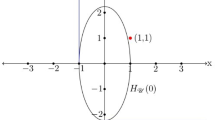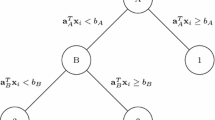Abstract
By representing the constraints and objective function in factorized form, graphical models can concisely define various NP-hard optimization problems. They are therefore extensively used in several areas of computer science and artificial intelligence. Graphical models can be deterministic or stochastic, optimize a sum or product of local functions, defining a joint cost or probability distribution. Simple transformations exist between these two types of models, but also with MaxSAT or linear programming. In this paper, we report on a large comparison of exact solvers which are all state-of-the-art for their own target language. These solvers are all evaluated on deterministic and probabilistic graphical models coming from the Probabilistic Inference Challenge 2011, the Computer Vision and Pattern Recognition OpenGM2 benchmark, the Weighted Partial MaxSAT Evaluation 2013, the MaxCSP 2008 Competition, the MiniZinc Challenge 2012 & 2013, and the CFLib (a library of Cost Function Networks). All 3026 instances are made publicly available in five different formats and seven formulations. To our knowledge, this is the first evaluation that encompasses such a large set of related NP-complete optimization frameworks, despite their tight connections. The results show that a small number of evaluated solvers are able to perform well on multiple areas. By exploiting the variability and complementarity of solver performances, we show that a simple portfolio approach can be very effective. This portfolio won the last UAI Evaluation 2014 (MAP task).


Similar content being viewed by others
Notes
Rational costs are also used in [11].
Script available at http://genoweb.toulouse.inra.fr/degivry/evalgm/scripts/wcsp2markov.py
A 1-hour time limit was used to translate minizinc2 to flatzinc, readable by CP solvers.
Directly lifting a CP model, with its cost variable, to a CFN would be of limited value since all AC in CFN are known to enforce AC on cost functions representing hard constraints.
We restrict the size of cost functions to be less than 106 tuples in our implementation.
Alchemy and Promedas were solved by toulbar2 in less than 1 sec. each. CSP instances came from CFLib. ProteinProtein is already present in CVPR under the name of Protein Prediction ProteinInteraction.
The resulting wcsp instances were translated back to uai instances (with _digit2 extension) in order to optimize the same objective function.
mplp2 http://cs.nyu.edu/dsontag version 2 (using 2.10−7 gap thres.) was tested but the results are not presented in Section 4.3 as it was dominated in most categories by toulbar2.
https://github.com/lotten/daoopt open source version 1.1.2, not including the closed source and unavailable convergent message-passing bound tightening used in the PIC challenge.
http://www.inra.fr/mia/T/toulbar2 version 0.9.8, parameters -A -V -dee -hbfs.
http://www.maxhs.org version 2.51, no parameter.
http://www.gecode.org/ version 4.4.0, using free search.
Using parameter -pe parallel_smp 2 on a SUN Grid Engine to ensure half-load of the cores on the cluster.
More detailed results are available at http://genoweb.toulouse.inra.fr/degivry/evalgm.
The Z-score of a value x in a set of values is \(\frac {x-\mu }{\sigma }\) where μ is the mean of the set and σ its standard deviation.
The normalized total reduction brought by the feature.
https://github.com/9thbit/uai-proteus used a Random Forest classifier and an older version of toulbar2 version 0.9.7, with no parameter. Here we report the results using the same settings as in Sec. 4.3, incop+toulbar2 corresponds to toulbar2 using an extra parameter -i for the initial incop starting solution phase.
See MAP/Proteus entry at http://www.hlt.utdallas.edu/vgogate/uai14-competition/leaders.html.
See MAP/MIP-UAI and MAP/MIP-T-UAI entries.
See MAP/IncTb entry.
References
Allouche, D., Bessiere, C., Boizumault, P., Givry, S., Gutierrez, P., Loudni, S., Métivier, J., & Schiex, T. (2012). Decomposing global cost functions. In Proceedings of AAAI.
Allouche, D., de Givry, S., Katsirelos, G., Schiex, T., & Zytnicki, M. (2015). Anytime hybrid best-first search with tree decomposition for weighted CSP. In Proceedings of CP (pp. 12–28).
Allouche, D., Traoré, S., André, I., Givry, S., Katsirelos, G., Barbe, S., & Schiex, T. (2012). Computational protein design as a cost function network optimization problem. In Proceedings of CP (pp. 840–849).
Amadini, R., Gabbrielli, M., & Mauro, J. (2015). A Multicore Tool for Constraint Solving. In Proceedings of IJCAI (pp. 232–238).
Ansótegui, C., Malitsky, Y., & Sellmann, M. (2014). MaxSAT by Improved Instance-Specific Algorithm Configuration. In Proceedings of AAAI (pp. 2594–2600).
Argelich, J., Cabiscol, A., Lynce, I., & Manyà, F. (2008). Encoding Max-CSP into partial Max-SAT. In Proceedings of ISMVL (pp. 106–111).
Bacchus, F. (2007). GAC via unit propagation. In Proceedings of CP (pp. 133–147).
Bensana, E., Lemaître, M., & Verfaillie, G. (1999). Earth observation satellite management. Constraints, 4(3), 293–299.
Breiman, L., Friedman, J., Stone, C.J., & Olshen, R.A. (1984). Classification and regression trees: CRC press.
Cabon, B., de Givry, S., Lobjois, L., Schiex, T., & Warners, J. (1999). Radio link frequency assignment. Constraints, 4, 79–89.
Cooper, M, de Givry, S., Sanchez, M., Schiex, T., Zytnicki, M., & Werner, T. (2010). Soft arc consistency revisited. Artificial Intelligence, 174, 449–478.
Cooper, M., de Givry, S., & Schiex, T. (2007). Optimal soft arc consistency. In Proceedings of IJCAI (pp. 68–73).
Cooper, M.C., & Schiex, T. (2004). Arc consistency for soft constraints. Artificial Intelligence, 154(1-2), 199–227.
Davies, J., & Bacchus, F. (2011). Solving MAXSAT by solving a sequence of simpler SAT instances. In Proceedings of CP (pp. 225–239).
Davies, J., & Bacchus, F. (2013). Exploiting the power of MIP solvers in MaxSAT. In Proceedings of SAT (pp. 166–181).
Dechter, R. (1999). Bucket elimination: A unifying framework for reasoning. Artificial Intelligence, 113(1–2), 41–85.
Fargier, H., Lang, J., Martin-Clouaire, R., & Schiex, T. (1995). A constraint satisfaction framework for decision under uncertainty. In Proceedings of the 11th International Conference on Uncertainty in Artificial Intelligence. Montréal.
Favier, A., Givry, S., Legarra, A., & Schiex, T. (2011). Pairwise decomposition for combinatorial optim. in graphical models. In Proceedings of IJCAI (pp. 2126–2132).
de Givry, S., Prestwich, S., & O’Sullivan, B. (2013). Dead-end elimination for weighted CSP. In Proceedings of CP (pp. 263–272).
Globerson, A., & Jaakkola, T. (2007). Fixing max-product: Convergent message passing algorithms for MAP LP-relaxations. In Proceedings of NIPS (pp. 553–560).
Gomes, C.P., & Selman, B. (2001). Algorithm Portfolios. Artificial Intelligence, 126(1-2), 43–62.
Hebrard, E., O’Mahony, E., & O’Sullivan, B. (2010). Constraint Programming and Combinatorial Optimisation in Numberjack. In Proceedings of CP-AI-OR (pp. 181–185).
Huberman, B.A., Lukose, R.M., & Hogg, T. (1997). An economics approach to hard computational problems. Science, 275(5296), 51–54.
Hurley, B., Kotthoff, L., Malitsky, Y., & O’Sullivan, B. (2014). Proteus: A hierarchical portfolio of solvers and transformations. In Proceedings of CP-AI-OR (pp. 301–317).
Jünger, M., Liebling, T., Naddef, D., Nemhauser, G., Pulleyblank, W., Reinelt, G., Rinaldi, G., & Wolsey, L. (Eds.) (2010). 50 years of integer programming 1958–2008: Springer.
Kadioglu, S., Malitsky, Y., Sellmann, M., & Tierney, K. (2010). ISAC – Instance-specific algorithm configuration. In Proceedings of ECAI (pp. 751–756).
Kappes, J., Andres, B., Hamprecht, F., Schnȯrr, C., Nowozin, S., Batra, D., Kim, S., Kausler, B., Krȯger, T., Lellmann, J., Komodakis, N., Savchynskyy, B., & Rother, C. (2015). A comparative study of modern inference techniques for structured discrete energy minimization problems. International Journal of Computer Vision, 115(2), 155–184.
Kishimoto, A., & Marinescu, R. (2013). Recursive best-first and/or search with overestimation for genetic linkage analysis. In Proceedings of CP workshop on constraint based methods for bioinformatics.
Koller, D., & Friedman, N. (2009). Probabilistic graphical models: Principles and techniques: The MIT Press.
Koster, A. (1999). Frequency assignment: Models and algorithms. Ph.D. thesis.
Kotthoff, L. (2013). LLAMA: leveraging learning to automatically manage algorithms. Tech. Rep. arXiv:1306.1031.
Kotthoff, L. (2014). Algorithm Selection for combinatorial search problems: a survey. AI Magazine, 35(3), 48–60.
Kratica, J., Toṡic, D., Filipović, V., & Ljubić, I. (2001). Solving the simple plant location problem by genetic alg. RAIRO, 35(1), 127–142.
Larrosa, J, de Givry, S., Heras, F., & Zytnicki, M. (2005). Existential arc consistency: getting closer to full arc consistency in weighted CSPs. In Proceedings of IJCAI (pp. 84–89).
Larrosa, J., Heras, F, & de Givry, S. (2008). A logical approach to efficient max-sat solving. Artificial Intelligence, 172(2-3), 204–233.
Li, C.M., & Manyà, F. (2009). Maxsat. In Handbook of satisfiability, chap. 19: IOS Press.
Meltzer, T., Globerson, A., & Weiss, Y. (2009). Convergent message passing algorithms: a unifying view. In Proceedings of the twenty-fifth conference on uncertainty in artificial intelligence (pp. 393–401): AUAI Press.
Meseguer, P., Rossi, F., & Schiex, T. (2006). Soft constraints processing. In Rossi, F., van Beek, P., & Walsh, T. (Eds.) Handbook of constraint programming, chap. 9: Elsevier.
Nethercote, N., Stuckey, P., Becket, R., Brand, S., Duck, G., & Tack, G. (2007). MiniZinc: Towards a standard CP modelling language, (pp. 529–543).
Neveu, B., Trombettoni, G., & Glover, F. (2004). Id walk: A candidate list strategy with a simple diversification device. In Proceedings of CP (pp. 423–437).
O’Mahony, E., Hebrard, E., Holland, A., Nugent, C., & O’Sullivan, B. (2008). Using case-based reasoning in an algorithm portfolio for constraint solving: Irish Conference on Artificial Intelligence and Cognitive Science.
Otten, L., Ihler, A., Kask, K., & Dechter, R. (2012). Winning the PASCAL 2011 MAP challenge with enhanced AND/OR branch-and-bound. In NIPS DISCML Workshop.
Petit, T., Régin, J., & Bessière, C. (2000). Meta constraints on violations for over constrained problems. In Proceedings of ICTAI (pp. 358–365).
Prusa, D., & Werner, T. (2015). Universality of the local marginal polytope. IEEE Transactions on Pattern Analysis and Machine Intelligence, 37(4), 898–904.
Rossi, F., van Beek, P., & Walsh, T. (Eds.) (2006). Handbook of constraint programming: Elsevier.
Sánchez, M, de Givry, S., & Schiex, T. (2008). Mendelian error detection in complex pedigrees using weighted constraint satisfaction techniques. Constraints, 13 (1–2), 130–154.
Schlesinger, M. (1976). Syntactic analysis of two-dimensional visual signals in noisy conditions. Kibernetika, 4, 113–130.
Sontag, D., Choe, D., & Li, Y. (2012). Efficiently searching for frustrated cycles in MAP inference. In Proceedings of UAI (pp. 795–804).
Sontag, D., Meltzer, T., Globerson, A., Weiss, Y., & Jaakkola, T. (2008). Tightening LP relaxations for MAP using message-passing. In Proceedings of UAI (pp. 503–510).
Werner, T. (2007). A linear programming approach to max-sum problem. Pattern Analysis and Machine Intelligence, 29(7), 1165–1179.
Xu, L., Hutter, F., Hoos, H.H., & Leyton-Brown, K. (2008). SATzilla: Portfolio-based algorithm selection for SAT. In Journal of artificial intelligence research (pp. 565–606).
Acknowledgments
We are grateful to the GenoToul (Toulouse) Bioinformatic platform for providing us computational support for this work. This work is supported by Science Foundation Ireland (SFI) Grant 10/IN.1/I3032. The Insight Centre for Data Analytics is supported by SFI Grant SFI/12/RC/2289.
Author information
Authors and Affiliations
Corresponding author
Rights and permissions
About this article
Cite this article
Hurley, B., O’Sullivan, B., Allouche, D. et al. Multi-language evaluation of exact solvers in graphical model discrete optimization. Constraints 21, 413–434 (2016). https://doi.org/10.1007/s10601-016-9245-y
Published:
Issue Date:
DOI: https://doi.org/10.1007/s10601-016-9245-y




